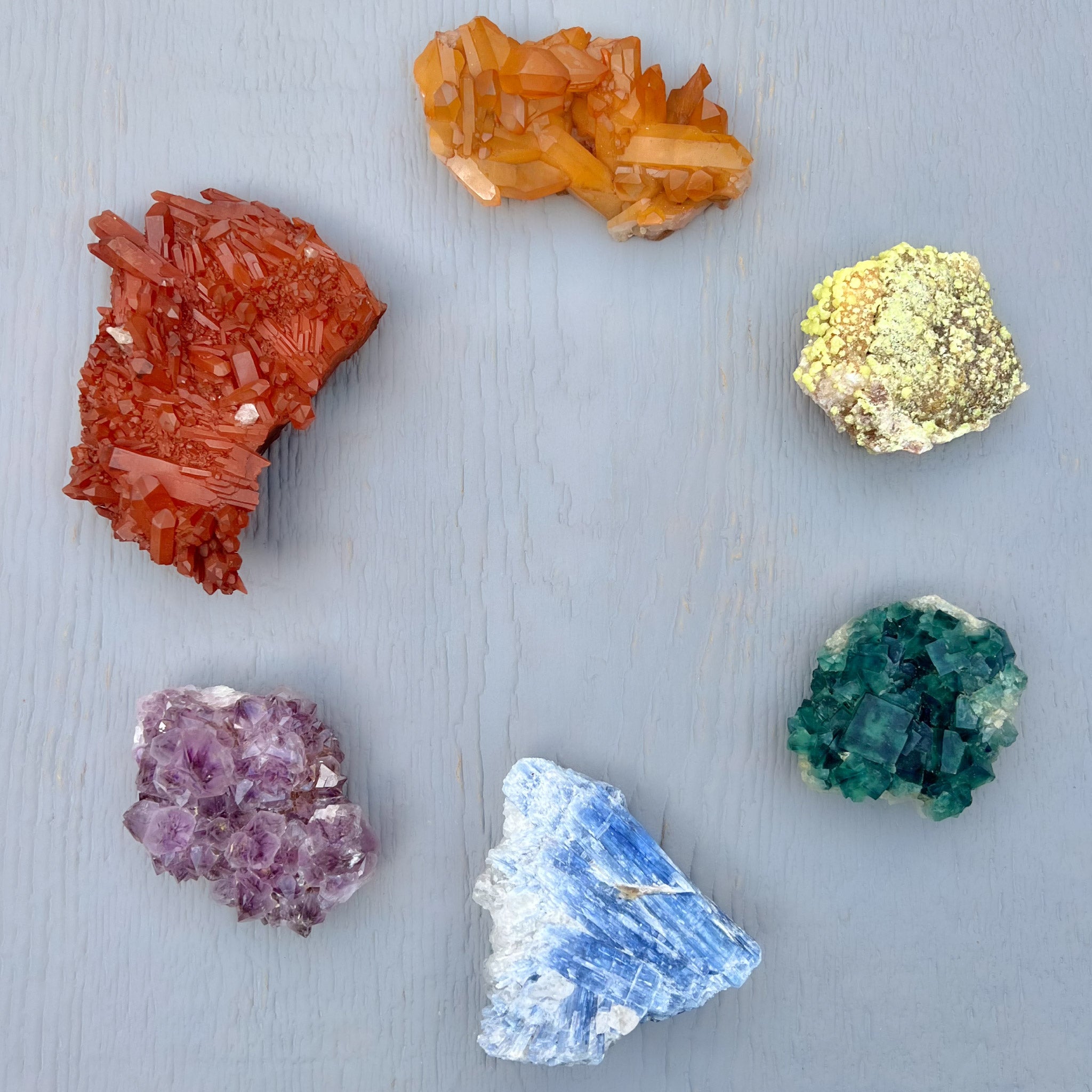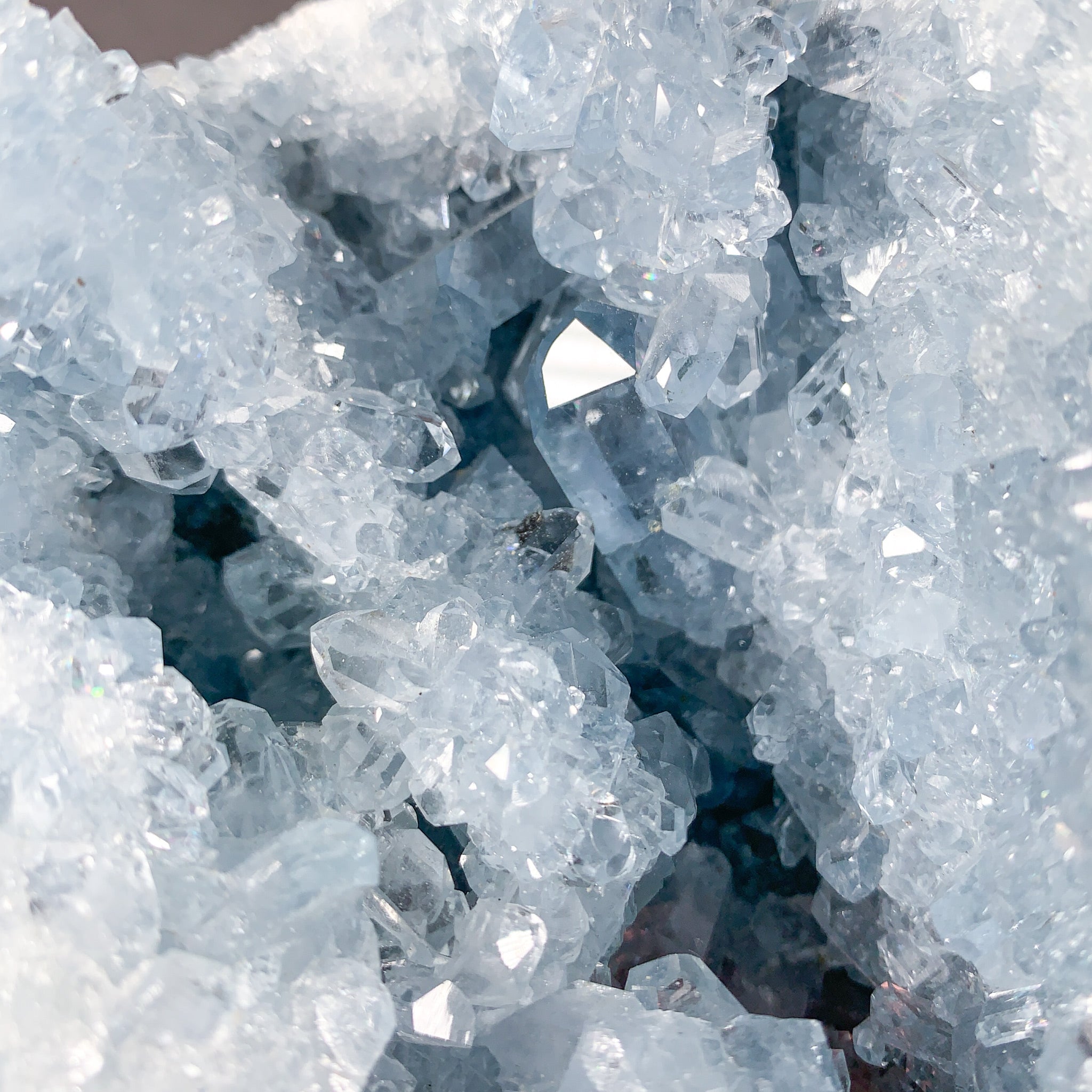Why Do Crystals Form in Different Shapes?
Ever wonder why some minerals form into nice crystal points and others form into cubes or discs? Or have you ever found a specimen of Fluorite that looks completely different from another specimen also labeled Fluorite. What gives?
We're going to explore mineral shapes and explain why even the same type of mineral can actually form into many different crystal shapes!
Please keep in mind that Mineralogy (the study of the physical properties, crystal chemistry, and shape of minerals) is a HUGE discipline with lots of information. We're going to discuss the common terminology you might run into while shopping for crystals or mineral specimens.
What is a Mineral?
A mineral is a naturally occurring, usually inorganic solid, with a definite chemical composition and an organized internal structure.
The internal atomic structure and the environmental conditions in which a mineral develops are the most important factors in determining the final crystal shape of a mineral.
Internal Structure vs. Outward Appearance
What is Crystal Form vs. Crystal Habit?
In general terminology, form would be used to describe the outward appearance (shape) of an object. But in mineralogy, the external shape is described by the term habit, and the crystals form describes a group of crystal faces, all of which have the same relation to the elements of symmetry inherent in the crystal.
Crystal Form (morphology) - is the outward expression of the minerals internal ordered atomic arrangement, i.e. the regular geometric shape of a mineral/crystal. If a mineral specimen exhibits a good crystal outline and formed under favorable geologic conditions, it in theory, should exhibit a shape specifically related to its internal (atomic) structure.
Crystal Habit - refers to the external expression of the minerals shape and any irregularities in growth which may be altered due to environmental conditions as the crystals were developing.
Example: Here's an example using cake as an analogy. Because who doesn't love cake? And rocks!
Let's say you are making two identical cakes. You measure the same ingredients perfectly, and follow the same exact recipe, same cooking time in the oven at the same temperature.
Cake 1 is our Crystal Form cake
This is our perfectly baked cake. If the ingredients were added correctly, and it had favorable baking conditions (cake mold, proper temperature inside the oven, cooking time, etc.), you could have the perfect cake with the perfect shape.
Cake 2 is our Crystal Habit cake
This is the same type of cake as Cake 1, with the same ingredients, same temperature, same cooking time, but underwent slightly different baking ("growing") conditions. Maybe you put the batter in a misshapen cake mold, or you tried the same recipe at a different altitude. In the end you would get the same type of cake, but one that exhibits a variable shape (habit).
How Does the Geologic Growing Environment Affect the Crystal Shape / Habit?
As discussed above, the term HABIT is used to describe the general shape of crystals as fibrous, banded, stalactitic, tabular, etc. Crystal habit is controlled by the environment in which the crystal formed, and can vary greatly based upon the locality.
This is how a mineral like Fluorite can look like a cube, or like an octahedron, or sometimes even rounded like grapes (botryoidal). It is the same mineral, with the same chemistry, but with a very different HABIT or shape depending on the growing conditions.
Only rarely do crystals present a perfect or morphologically "ideal" geometrical shape.
So environmentally, how would this happen? Here's an example:
You have a solution of Quartz crystals growing in a pocket or void within the host rock. It is the same chemical solution, SiO2 (silicon dioxide), and the crystals are growing in the same general place. But one of the crystals starts growing up against a fracture in the host rock, and causes the Quartz to flatten out in a more tabular appearance. This would be an example of a Quartz crystal showing a Tabular habit.
Common Types of Crystal Habits / Shapes
There are MANY types of crystal habits / shapes out there, so here are a few common descriptions to get you started:
Massive - These are "blobs" of a mineral that lack defined crystal faces
Micaceous - These are minerals composed of layers and thin "sheets" that can easily be separated, sort of like the pages of a book
Bladed - Flatted crystals, sometimes elongated with a bladed appearance
Fibrous / Acicular - Needle-like grains or fibers of crystals
Radiating - Acicular crystals that radiate from a central point
Banded - Thin, roughly parallel bands or banding of a mineral
Botryoidal - Smaller rounds of crystals resembling a bunch of grapes
Stalactitic - Dripping formation of usually conical or cylindrical crystals, similar to the shapes of stalactites found in caves
Tabular - Longer than wide crystals
Prismatic - Prism shaped
Cubic - Forms in the shape of a cube with 6 equal faces
Octahedral - Forms in the shape of an octahedron with 8 equal faces, looks like a pyramid stacked on top of an inverted pyramid on the bottom
What are Crystal Systems / Crystal Classes?
You may have heard people refer to mineral specimens by saying "Look at this Cubic Pyrite" or "That Quartz has a Hexagonal crystal structure". But what does that mean?
Using a set of imaginary reference lines, the external forms or internal symmetry of a crystal can be described through a set of reference axes. The number of faces that belong to a mineral is determined by the symmetry of the crystal class or point group. Faces of a mineral may be different shapes and sizes due to distortion of the crystal.
Triclinic - Three unequal axes all intersecting at oblique angles.
Example: Microcline (Amazonite) is Triclinic
Monoclinic - Three unequal axes, two of which are inclined to each other at an oblique angle, and the third is perpendicular to the plane of the other two.
Example: Muscovite (mica) is Monoclinic
Orthorhombic - Three mutually perpendicular axes all of different lengths.
Example: Hemimorphite is Orthorhombic
Tetragonal - Three mutually perpendicular axes, two of which (the horizontal axes) are of equal length, but the vertical axis is shorter or longer than the other two.
Example: Rutile is Tetragonal
Hexagonal - Four crystallographic axes, three equal horizontal axes intersect at angles of 120 degrees, the fourth vertical axis is of different length and perpendicular to the plane of the other three. Trigonal is one, three-fold axis of rotation, and Hexagonal is one, six-fold axis of rotation. Trigonal is also the designation where Rhombohedrons form.
Example: Quartz is Hexagonal
Isometric / Cubic - Three mutually perpendicular axes of equal length.
Example: Pyrite and Fluorite are Isometric / Cubic
Conclusion
We have only just begun to scratch the mineralogical surface here, but hopefully you have come away with some additional knowledge of terms you may have heard thrown around while shopping for crystal and mineral specimens!




